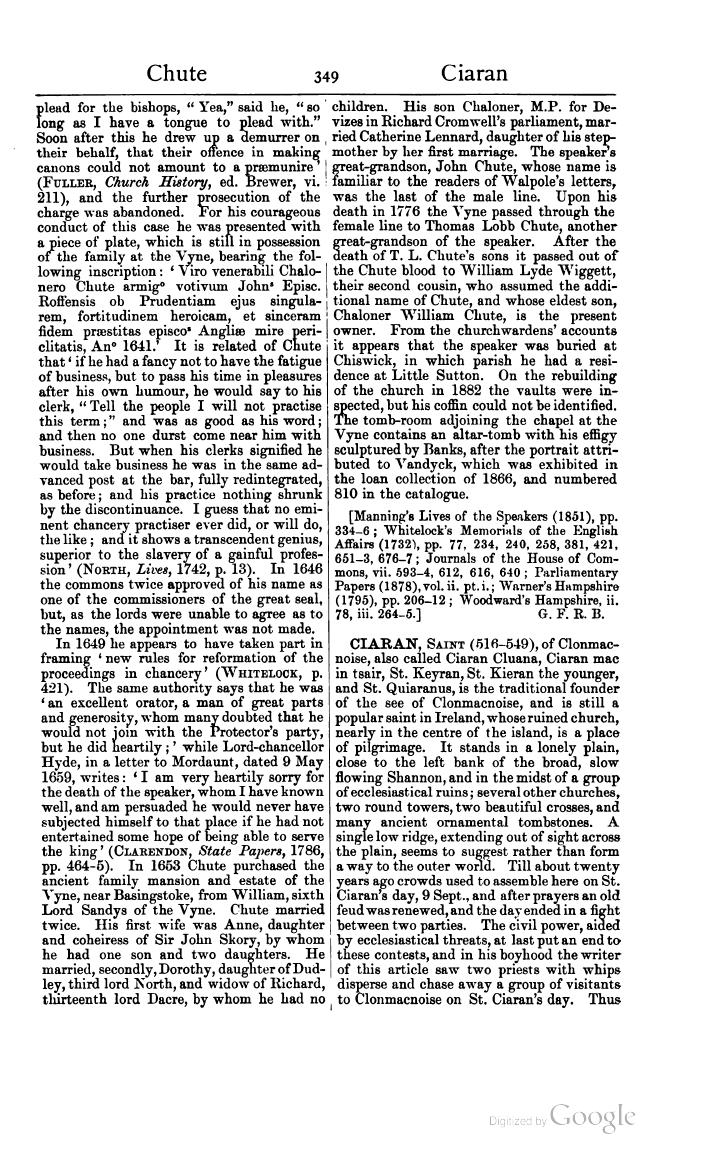plead for the bishops, "Yea," said he, "so long as I have a tongue to plead with." Soon after this he drew up a demurrer on their behalf, that their offence in making canons could not amount to a præmunire (Fuller, Church History, ed. Brewer, vi. 211), and the further prosecution of the charge was abandoned. For his courageous conduct of this case he was presented with a piece of plate, which is still in possession or the family at the Vyne, bearing the following inscription : 'Viro venerabili Chalonero Chute armiga votivum Johna Episc. Roffensis ob Prudentiam ejus singularem, fortitudinem heroicam, et sinceram firem, præstitas episco' Angliæ mire perictatis, Ano 1641. It is related of Cnute that 'if he had a fancy not to have the fatigue of business, but to pass his time in pleasures after his own humour, he would say to his clerk, "Tell the people I will not practise this term;" and was as good as his word; and then no one durst come near him with business. But when his clerks signified he would take business he was in the same advanced post at the bar, fully redintegrated, as before; and his practice nothing shrunk by the discontinuance. I guess that no eminent chancery practiser ever did, or will do, the like; and it shows a transcendent genius, superior to the slavery of a gainful profession' (North, Lives, 1742, p. 13). In 1646 the commons twice approved of his name as one of the commissioners of the great seal, but, as the lords were unable to agree as to the names, the appointment was not made.
In 1649 he appears to have taken part in framing 'new rules for reformation of the proceedings in chancery' (Whitelook, p. 421). The same authority says that he was 'an excellent orator, a man of great parts and generosity, whom many doubted that he would not join with the Protector's party, but he did heartily; 'while Lord-chancellor Hyde, in a letter to Mordaunt, dated 9 May 1669, writes: 'I am very heartily sorry for the death of the speaker, whom I have known well, and am persuaded he would never have subjected himself to that place if he had not entertained some hope of being able to serve the king' (Clarendon, State Papers, 1786, pp. 464-5). In 1653 Chute purchased the ancient family mansion and estate of the Vyne, near Basingstoke, from William, sixth Lord Sandys of the Vyne. Chute married twice. His first wife was Anne, daughter and coheiress of Sir John Skory, by whom he had one son and two dauffhters. He married, secondly, Dorothy, daugnter of Dudley, third lord North, and widow of Richard, thirteenth lord Dacre, by whom he had no children. His son Chaloner, M.P. for Devizes in Richard Cromwell's parliament, married Catherine Lennard, daughter of his step-mother by her first marriage. The speakers great-grandson, John Chute, whose name is familiar to the readers of Walpole's letters, was the last of the male line. Upon his death in 1776 the Vyne passed through the female line to Thomas Lobb Chute, another great-grandson of the speaker. After the death of T. L. Chute's sons it passed out of the Chute blood to William Lyde Wiggett, their second cousin, who assumed the additional name of Chute, and whose eldest son, Chaloner William Chute, is the present owner. From the churchwardens' accounts it appears that the speaker was buried at Chiswick, in which parish he had a residence at Little Sutton. On the rebuilding of the church in 1882 the vaults were inspected, but his coffin could not be identified. The tomb-room adjoining the chapel at the Vyne contains an altar-tomb with his effigy sculptured by Banks, after the portrait attributed to Vandyck, which was exhibited in the loan collection of 1866, and numbered 810 in the catalogue.
[Manning's Lives of the Speakers (1851), pp. 334-6; Whitelock's Memorials of the English Affaire (1732), pp. 77, 234, 240, 258, 381, 421, 651-3, 676-7; Journals of the House of Commons, vii. 593-4, 612, 616, 640; Parliamentary Papers (1878), vol. ii. pt.i.; Warner's Hampshire (1795), pp. 206-12; Woodward's Hampshire, ii. 78, iii. 264-5.]
CIARAN, Saint (516–549), of Clonmacnoise, also called Ciaran Cluana, Ciaran mac in tsair, St. Keyran, St. Kieran the younger, and St. Quiaranus, is the traditional founder of the see of Clonmacnoise, and is still a popular saint in Ireland, whose ruined church, nearly in the centre of the island, is a place of pilgrimage. It stands in a lonely plain, close to the left bank of the broad, slow flowing Shannon, and in the midst of a group of ecclesiastical ruins; several other churches two round towers, two beautiful crosses, and many ancient ornamental tombstones. A single low ridge, extending out of sight across the plain, seems to suggest rather than form a way to the outer wond. Till about twenty years ago crowds used to assemble here on St. Ciaran day, 9 Sept., and after prayers an old feud was renewed, and the day ended in a fight between two parties. The civil power, aided by ecclesiastical threats, at last put an end to these contests, and in his boyhood the writer of this article saw two priests with whips disperse and chase away a group of visitants to Clonmacnoise on St. Ciaran's day. Thus
